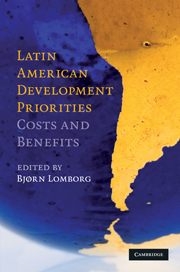Book contents
- Frontmatter
- Contents
- List of figures
- List of tables
- List of contributors
- Acknowledgments
- Abbreviations and acronyms
- Expert panel findings
- Introduction
- Democracy
- Education
- Employment and social security
- Environment
- Fiscal problems
- Health
- Infrastructure
- Poverty
- 8 Reducing poverty in the LAC region
- 8.1 Reducing poverty: an alternative view
- Public administration
- Violence and crime
- Conclusion
- References
8.1 - Reducing poverty: an alternative view
Published online by Cambridge University Press: 05 June 2012
- Frontmatter
- Contents
- List of figures
- List of tables
- List of contributors
- Acknowledgments
- Abbreviations and acronyms
- Expert panel findings
- Introduction
- Democracy
- Education
- Employment and social security
- Environment
- Fiscal problems
- Health
- Infrastructure
- Poverty
- 8 Reducing poverty in the LAC region
- 8.1 Reducing poverty: an alternative view
- Public administration
- Violence and crime
- Conclusion
- References
Summary
Introduction
Sebastian Galiani's chapter 8 proposes three solutions to the challenge of poverty and inequality in Latin America: nutritional interventions, conditional cash transfers (CCTs), and early childhood development (ECD) programs. His coverage of these topics is careful and thorough, leaving me with only a few concrete objections to his benefit-cost (B/C) estimates that may be useful for the Expert panel. Most of these are questions about the external validity of benefits and costs estimated from studies conducted outside of the LAC region. I will present these fairly limited comments in the second part of this alternative view. But my main criticism is that the scope of the solutions that Galiani offers is too narrow, in two ways. First, his B/C calculations focus on average benefits, without distinguishing benefits conditional on one's position in the income distribution. While this may aid comparability with other chapters in the volume, it seems an important oversight for a chapter on poverty and inequality, where distributional considerations should be of prime importance. Second, the main focus of Galiani's solutions is investments in children's human capital which will reduce (income) poverty only in the future.
- Type
- Chapter
- Information
- Latin American Development PrioritiesCosts and Benefits, pp. 498 - 514Publisher: Cambridge University PressPrint publication year: 2010



